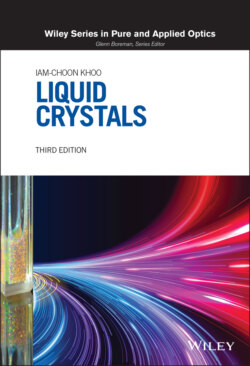Читать книгу Liquid Crystals - Iam-Choon Khoo - Страница 22
1.4.2. Dye‐doped Liquid Crystals
ОглавлениеAn obvious effect of introducing dye molecule to liquid crystals is to increase the absorption of a particular liquid crystal at some specified wavelength region. In particular, dye molecules with absorption anisotropy, or those that undergo conformation changes such as trans–cis isomorphism or produce photo‐charges, are often used for photonic applications [15–17]. For example, dichroic dye molecules that are more absorptive for optical field polarization parallel than perpendicular to its long axis are often used for the guest–host effect as their oblong shape makes them compatible for dispersing in the host nematic liquid crystals without disturbing the order. These dichroic molecules can then be oriented and reoriented by an external field applied to the host NLC to switch the transmission of the cell (cf. Figure 1.17); such dichroic dye‐doped liquid crystals have been utilized to demonstrate optical diode action [15] in the transmission of polarized light.
If the dye molecules undergo some physical changes such as trans–cis isomorphism or produce space charges following photon absorption, they could give rise to nonlinear optical effects [16]; others [17] have shown that dye molecules deposited on the cell windows can be optically aligned as an effective means of surface alignment mechanism for LC cell fabrication. These and other effects due to the presence of dye molecules or other photosensitive agents in liquid crystals are discussed in more detail in Chapter 8.
